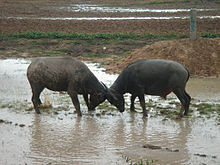| Revision as of 10:50, 8 November 2011 view sourceFavonian (talk | contribs)Autopatrolled, Administrators287,587 editsm Protected Buffalo buffalo Buffalo buffalo buffalo buffalo Buffalo buffalo: Persistent vandalism ( (expires 10:50, 8 February 2012 (UTC)) (expires 10:50, 8 February 2012 (UTC)))← Previous edit | Revision as of 10:51, 8 November 2011 view source Favonian (talk | contribs)Autopatrolled, Administrators287,587 editsm PadlockNext edit → | ||
| Line 1: | Line 1: | ||
| {{pp-semi-vandalism|small=yes|expiry=February 8, 2012}} | |||
| ] | ] | ||
| <br/> | <br/> | ||
Revision as of 10:51, 8 November 2011

PN = proper noun
N = noun
V = verb
NP = noun phrase
RC = relative clause
VP = verb phrase
S = sentence
"Buffalo buffalo Buffalo buffalo buffalo buffalo Buffalo buffalo." is a grammatically valid sentence in the English language, used as an example of how homonyms and homophones can be used to create complicated linguistic constructs. It has been discussed in literature since 1972 when the sentence was used by William J. Rapaport, an associate professor at the University at Buffalo. It was posted to Linguist List by Rapaport in 1992. It was also featured in Steven Pinker's 1994 book The Language Instinct.
Sentence construction




The sentence is unpunctuated and uses three different readings of the word "buffalo". In order of their first use, these are
- a. the city of Buffalo, New York, United States, which is used as a noun adjunct in the sentence and is followed by the animal;
- n. the noun buffalo, an animal, in the plural (equivalent to "buffaloes" or "buffalos"), in order to avoid articles;
- v. the verb "buffalo" meaning to bully, confuse, deceive, or intimidate.
Marking each "buffalo" with its use as shown above gives:
- Buffalo buffalo Buffalo buffalo buffalo buffalo Buffalo buffalo.
Thus, the sentence when parsed reads as a claim that bison who are intimidated or bullied by bison are themselves intimidating or bullying to bison (at least in the city of Buffalo -- implicitly, Buffalo, NY):
- (Buffalo buffalo) (Buffalo buffalo) buffalo, buffalo (Buffalo buffalo).
- buffalo(es) from Buffalo buffalo(es) from Buffalo intimidate buffalo(es) from Buffalo.
- Bison from Buffalo, New York, who are intimidated by other bison in their community, also happen to intimidate other bison in their community.
- THE buffalo FROM Buffalo WHO ARE buffaloED BY buffalo FROM Buffalo, buffalo (verb) OTHER buffalo FROM Buffalo.
- Buffalo buffalo (main clause subject) Buffalo buffalo (subordinate clause subject) buffalo (subordinate clause verb) buffalo (main clause verb) Buffalo buffalo (main clause direct object).
The sentence can be clarified by substituting the synonym "bison" for the animal "buffalo", "bully" for the verb "buffalo", and "New York" to refer to the state of the city Buffalo:
- "New York bison New York bison bully bully New York bison", or:
- "New York bison whom other New York bison bully, themselves bully New York bison".
Removing the classifier noun "Buffalo" (the city) further clarifies the sentence (note that the initial capital is retained as the common noun "buffalo" now starts the sentence):
- "Buffalo buffalo buffalo buffalo buffalo."
- "Bison bison bully bully bison."
Translation (first order logic)
Given domain = the set of all buffalo (animal), FB(x) = 'x is from Buffalo (place)' and B(x, y) = 'x buffalos (verb) y', the sentence can be translated into first order logic as follows:
Usage
There is nothing special about eight "buffalos"; indeed, a sentence with "buffalo" repeated any number of times is grammatically correct (according to Chomskyan theories of grammar). The shortest is "Buffalo!", meaning either "Bully (someone)!", or "Look, there are buffalo here!", or "Behold, it is the majestic and grand city of Buffalo!"
Other words
Other English words can be used to make grammatical (but not necessarily meaningful) sentences of this form, containing endless consecutive repetitions. Any word that is both an animate plural noun and a transitive verb will work. Other words which can be used in this manner include police, fish, smelt, char, people, can, and bream.
A somewhat similar un-punctuated example is "James while John had had had had had had had had had had had a better effect on the teacher". This could concern a situation in an English class regarding the usage of the word had, and might be punctuated as, "James, while John had had 'had', had had 'had had'; 'had had' had had a better effect on the teacher."
See also
Notes
- Rapaport, William J. 22 September 2006. "A History of the Sentence "Buffalo buffalo buffalo Buffalo buffalo."". Accessed 23 September 2006. (archived copy)
- Rapaport, William J. 19 February 1992. "Message 1: Re: 3.154 Parsing Challenges". Accessed 14 September 2006.
- Pinker, Steven. The Language Instinct: How the Mind Creates Language. William Morrow and Company, Inc., New York, 1994. p. 210
- Thomas Tymoczko; James M. Henle (2000). Sweet reason: a field guide to modern logic (2 ed.). Birkhäuser. pp. 99–100. ISBN 9780387989303.
External links
Listen to this article(2 parts, 5 minutes)
- "Buffaloing buffalo" at Language Log, 20 January 2005
- Easdown, David. Template:PDF
- The Emory Wheel, Andrew Swerlick What a Herd of Confused Bison from Upstate New York Can Teach Us About Our Difficulties With the English Language
